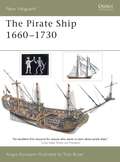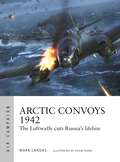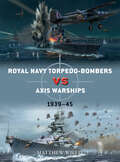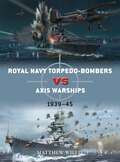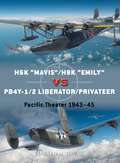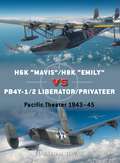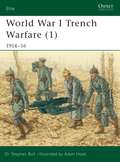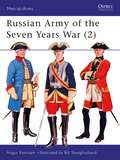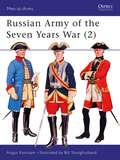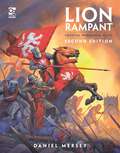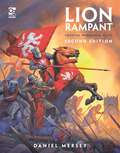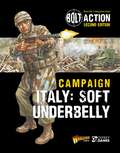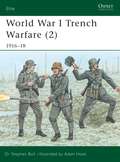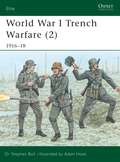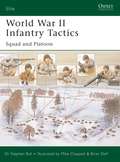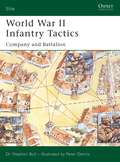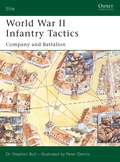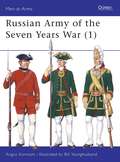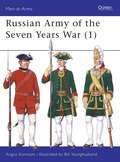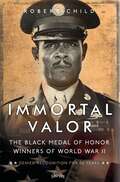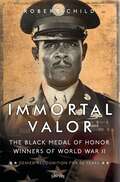- Table View
- List View
The Pirate Ship 1660–1730 (New Vanguard)
by Angus KonstamThe deeds and personalities of famous pirates have received significant attention in recent years: however, no detailed depiction of their vessels has ever been produced. This title redresses the imbalance, conducting a detailed exploration of the wide variety of pirate vessels that sailed the high seas during the 'golden age' of piracy (1690–1730), from gun-bristling warships to smaller craft such as sloops, brigantines and early schooners. It incorporates the latest archaeological evidence to produce a fascinating account of these vessels, detailing their origins, development and tactical engagement. Packed with contemporary illustrations and superbly detailed colour artwork, the ships of the 'golden age' are brought vividly to life.
Arctic Convoys 1942: The Luftwaffe cuts Russia's lifeline (Air Campaign)
by Mark LardasA new history of the most crucial few months of the Arctic Convoys, when Germany's air power forced the Allies to retreat to the cover of winter. Between spring and autumn 1942, Germany was winning the battle of the Arctic Convoys. Half of PQ-15 was sunk in May, PQ-17 was virtually obliterated in July, and in September 30 percent of PQ-18 was sunk. The Allies were forced to suspend the convoys until December, when the long Arctic nights would shield them.Mark Lardas argues that in 1942, it was Luftwaffe air power that made the difference. With convoys sailing in endless daylight, German strike aircraft now equipped and trained for torpedo attacks, and bases in northern Norway available, the Luftwaffe could wreak havoc. Three-quarters of the losses of PQ-18 were due to air attacks. But in November, the Luftwaffe was redeployed south to challenge the Allied landings in North Africa, and the advantage was lost. Despite that, the Allies never again sailed an Arctic convoy in the summer months.Fully illustrated with archive photos, striking new artwork, maps and diagrams, this is the remarkable history of the Luftwaffe's last strategic victory of World War II.
Arctic Convoys 1942: The Luftwaffe cuts Russia's lifeline (Air Campaign)
by Mark LardasA new history of the most crucial few months of the Arctic Convoys, when Germany's air power forced the Allies to retreat to the cover of winter. Between spring and autumn 1942, Germany was winning the battle of the Arctic Convoys. Half of PQ-15 was sunk in May, PQ-17 was virtually obliterated in July, and in September 30 percent of PQ-18 was sunk. The Allies were forced to suspend the convoys until December, when the long Arctic nights would shield them.Mark Lardas argues that in 1942, it was Luftwaffe air power that made the difference. With convoys sailing in endless daylight, German strike aircraft now equipped and trained for torpedo attacks, and bases in northern Norway available, the Luftwaffe could wreak havoc. Three-quarters of the losses of PQ-18 were due to air attacks. But in November, the Luftwaffe was redeployed south to challenge the Allied landings in North Africa, and the advantage was lost. Despite that, the Allies never again sailed an Arctic convoy in the summer months.Fully illustrated with archive photos, striking new artwork, maps and diagrams, this is the remarkable history of the Luftwaffe's last strategic victory of World War II.
Royal Navy torpedo-bombers vs Axis warships: 1939–45 (Duel)
by Matthew WillisDrawing on rare, historical photography and specially commissioned artwork, Matthew Willis explores the heroic feats of the few Royal Navy's obsolescent biplanes that stood between the state-of-the-art Axis warships and their objectives.Focusing on the technical specifications of both opponents, using original records, and detailed armament and cockpit views, this book explores the key attributes and drawbacks of the disadvantaged Royal Navy torpedo-bombers against the mighty Regia Marina and Kriegsmarine destroyers and raiders, covering a wide range of sea battles, from the more famous attacks such as the strike on the Bismarck, the tragic events of the Channel Dash or the clash with the Italian battle fleet at Taranto, to less covered sea battles such as the Battle of Matapan.Despite their powerful weaponry and heavy armour protection, the Axis warships proved vulnerable to a skillfully and audaciously flown torpedo-bomber, thanks to innovative commanders exploiting every possible advantage. Including rare personal recollections from the airmen who flew the torpedo-bombers and historical accounts from the Axis warship crews, this book describes each and every facet of this dramatic duel.
Royal Navy torpedo-bombers vs Axis warships: 1939–45 (Duel)
by Matthew WillisDrawing on rare, historical photography and specially commissioned artwork, Matthew Willis explores the heroic feats of the few Royal Navy's obsolescent biplanes that stood between the state-of-the-art Axis warships and their objectives.Focusing on the technical specifications of both opponents, using original records, and detailed armament and cockpit views, this book explores the key attributes and drawbacks of the disadvantaged Royal Navy torpedo-bombers against the mighty Regia Marina and Kriegsmarine destroyers and raiders, covering a wide range of sea battles, from the more famous attacks such as the strike on the Bismarck, the tragic events of the Channel Dash or the clash with the Italian battle fleet at Taranto, to less covered sea battles such as the Battle of Matapan.Despite their powerful weaponry and heavy armour protection, the Axis warships proved vulnerable to a skillfully and audaciously flown torpedo-bomber, thanks to innovative commanders exploiting every possible advantage. Including rare personal recollections from the airmen who flew the torpedo-bombers and historical accounts from the Axis warship crews, this book describes each and every facet of this dramatic duel.
H6K “Mavis”/H8K “Emily” vs PB4Y-1/2 Liberator/Privateer: Pacific Theater 1943–45 (Duel)
by Edward M. YoungAn illustrated exploration of the dramatic aerial combats between the US Navy's long-range bomber and Japanese flying boats in the Pacific War.Edward Young explores these rarely written about combats, examining the aggressive and strategic tactics deployed by both US Navy and Imperial Japanese Navy Air Force and analyzing the technical improvements installed throughout the war.The PB4Y-1/2 Liberator/Privateer was the US Navy's first four-engined, land-based bomber, adapted and allocated to fight the U-boat menace in the Atlantic and protect the vast reaches of the Pacific Ocean. The long range, speed, armament and bomb load of the PB4Y-1 enabled the US Navy's Pacific squadrons to adopt more aggressive tactics. The PB4Y-1, and its follow-on PB4Y-2, engaged in dangerous bombing missions against Japanese installations, shipping strikes, and air combat. On the other side, with its doctrine of making the first strike against an enemy fleet, the Imperial Japanese Navy recognized the vital importance of maritime reconnaissance, relying on carrier-based reconnaissance aircraft, ship-borne floatplanes and, for long-range maritime patrol, flying boats. The Japanese would continue to develop their aircraft throughout the war, resulting, among others, in the H6K 'Mavis' and the H8K2 'Emily', which despite never achieving a victory, was regarded by the Allied pilots as the most difficult Japanese aircraft to destroy. Enriched with specially commissioned artwork, including armament and cockpit views, battlescenes and technical diagrams, this title analyses technical specifications in detail. By including first-hand accounts, aviation expert Edward Young provides a detailed account of these one-sided yet dramatic and aggressive combats.
H6K “Mavis”/H8K “Emily” vs PB4Y-1/2 Liberator/Privateer: Pacific Theater 1943–45 (Duel)
by Edward M. YoungAn illustrated exploration of the dramatic aerial combats between the US Navy's long-range bomber and Japanese flying boats in the Pacific War.Edward Young explores these rarely written about combats, examining the aggressive and strategic tactics deployed by both US Navy and Imperial Japanese Navy Air Force and analyzing the technical improvements installed throughout the war.The PB4Y-1/2 Liberator/Privateer was the US Navy's first four-engined, land-based bomber, adapted and allocated to fight the U-boat menace in the Atlantic and protect the vast reaches of the Pacific Ocean. The long range, speed, armament and bomb load of the PB4Y-1 enabled the US Navy's Pacific squadrons to adopt more aggressive tactics. The PB4Y-1, and its follow-on PB4Y-2, engaged in dangerous bombing missions against Japanese installations, shipping strikes, and air combat. On the other side, with its doctrine of making the first strike against an enemy fleet, the Imperial Japanese Navy recognized the vital importance of maritime reconnaissance, relying on carrier-based reconnaissance aircraft, ship-borne floatplanes and, for long-range maritime patrol, flying boats. The Japanese would continue to develop their aircraft throughout the war, resulting, among others, in the H6K 'Mavis' and the H8K2 'Emily', which despite never achieving a victory, was regarded by the Allied pilots as the most difficult Japanese aircraft to destroy. Enriched with specially commissioned artwork, including armament and cockpit views, battlescenes and technical diagrams, this title analyses technical specifications in detail. By including first-hand accounts, aviation expert Edward Young provides a detailed account of these one-sided yet dramatic and aggressive combats.
World War I Trench Warfare: 1914–16 (Elite)
by Stephen BullThe regular armies which marched off to war in 1914 were composed of massed riflemen, screened by cavalry and supported by artillery; their leaders expected a quick and decisive outcome, achieved by sweeping manoeuvre, bold leadership and skill at arms. Eighteen months later the whole nature of field armies and their tactics had changed utterly. In sophisticated trench systems forming a battlefield a few miles wide and 400 miles long, conscript armies sheltered from massive long-range bombardment, wielding new weapons according to new tactical doctrines. This first of two richly illustrated studies explains in detail the specifics of that extraordinary transformation, complete with ten full colour plates of uniforms and equipment.
World War I Trench Warfare: 1914–16 (Elite)
by Stephen BullThe regular armies which marched off to war in 1914 were composed of massed riflemen, screened by cavalry and supported by artillery; their leaders expected a quick and decisive outcome, achieved by sweeping manoeuvre, bold leadership and skill at arms. Eighteen months later the whole nature of field armies and their tactics had changed utterly. In sophisticated trench systems forming a battlefield a few miles wide and 400 miles long, conscript armies sheltered from massive long-range bombardment, wielding new weapons according to new tactical doctrines. This first of two richly illustrated studies explains in detail the specifics of that extraordinary transformation, complete with ten full colour plates of uniforms and equipment.
Russian Army of the Seven Years War (Men-at-Arms)
by Angus KonstamThis second volume (see MAA 297) by Angus Konstam on the Russian Army of the Seven Years War concentrates on the cavalry, both the regular troops and irregular forces, considering their composition, nature and effectiveness. It also outlines the state of the Russian train of artillery, which was seen as the premier branch of the army and dominated Russian military doctrine throughout the 18th century. As a result of reforms to the, the Russians entered the war with Prussia somewhat wrong footed. The ability of the army to recover from this in the crucible of war is a major part of this story.
Russian Army of the Seven Years War (Men-at-Arms)
by Angus KonstamThis second volume (see MAA 297) by Angus Konstam on the Russian Army of the Seven Years War concentrates on the cavalry, both the regular troops and irregular forces, considering their composition, nature and effectiveness. It also outlines the state of the Russian train of artillery, which was seen as the premier branch of the army and dominated Russian military doctrine throughout the 18th century. As a result of reforms to the, the Russians entered the war with Prussia somewhat wrong footed. The ability of the army to recover from this in the crucible of war is a major part of this story.
Lion Rampant: Medieval Wargaming Rules
by Daniel MerseyAn expanded edition of the Origins Award-nominated Lion Rampant, featuring new rules, scenarios, and sample armies.Take to the battlefield as Richard the Lionheart, Joan of Arc or William Wallace – or forge your own legend – with Lion Rampant: Second Edition. From the Dark Ages to the Hundred Years' War, raids, skirmishes, and clashes between small retinues were a crucial part of warfare, and these dramatic small-scale battles are at the heart of this easy-to-learn but tactically rewarding wargame. Lion Rampant: Second Edition is a new, updated version of the hit Osprey Wargames series title, and retains the core gameplay while also incorporating a wealth of new rules and updates from several years' worth of player feedback and development. Whether they are looking to recreate historical encounters or tell their own stories, the varied scenarios, unit types, and sample retinue lists found in this volume provide everything players need to face each other in quick, exciting, and, above all, fun tabletop battles.
Lion Rampant: Medieval Wargaming Rules
by Daniel MerseyAn expanded edition of the Origins Award-nominated Lion Rampant, featuring new rules, scenarios, and sample armies.Take to the battlefield as Richard the Lionheart, Joan of Arc or William Wallace – or forge your own legend – with Lion Rampant: Second Edition. From the Dark Ages to the Hundred Years' War, raids, skirmishes, and clashes between small retinues were a crucial part of warfare, and these dramatic small-scale battles are at the heart of this easy-to-learn but tactically rewarding wargame. Lion Rampant: Second Edition is a new, updated version of the hit Osprey Wargames series title, and retains the core gameplay while also incorporating a wealth of new rules and updates from several years' worth of player feedback and development. Whether they are looking to recreate historical encounters or tell their own stories, the varied scenarios, unit types, and sample retinue lists found in this volume provide everything players need to face each other in quick, exciting, and, above all, fun tabletop battles.
Bolt Action: Campaign: Italy: Soft Underbelly (Bolt Action)
by Warlord GamesWith the Axis Powers ejected from North Africa, the Western Allies look to take the fight across the Mediterranean and into Mussolini's Italy. This supplement for Bolt Action focuses on Operation Husky, the airborne and naval invasion of Sicily, the hard-fought battles in the villages and rugged mountain passes of that island, and the advance up the Italian Peninsula towards Rome. With a host of scenarios, new units, special rules, and Theatre Selectors this book contains everything players need to refight these important battles in defence of the Regno d'Italia or to strike at the underbelly of Axis-controlled Europe.
Bolt Action: Campaign: Italy: Soft Underbelly (Bolt Action)
by Warlord GamesWith the Axis Powers ejected from North Africa, the Western Allies look to take the fight across the Mediterranean and into Mussolini's Italy. This supplement for Bolt Action focuses on Operation Husky, the airborne and naval invasion of Sicily, the hard-fought battles in the villages and rugged mountain passes of that island, and the advance up the Italian Peninsula towards Rome. With a host of scenarios, new units, special rules, and Theatre Selectors this book contains everything players need to refight these important battles in defence of the Regno d'Italia or to strike at the underbelly of Axis-controlled Europe.
World War I Trench Warfare: 1916–18 (Elite)
by Stephen BullThe Allied attempt to break the stalemate of trench warfare by the 'big pushes' of 1916 led to massively costly battles of attrition. The Germans responded by developing schemes of defence in depth anchored on concrete bunkers; the Allies, by sophisticated artillery tactics in support of infantry assaults, and by the introduction of the tank - at first an accident-prone novelty, but later a front-breaking weapon. On both sides the small, self-reliant, opportunistic infantry unit, with its own specialist weapons, became the basic tool of attack. This second of a fascinating two-part study of the birth of 20th century tactics is illustrated in colour and includes rare photographs.
World War I Trench Warfare: 1916–18 (Elite)
by Stephen BullThe Allied attempt to break the stalemate of trench warfare by the 'big pushes' of 1916 led to massively costly battles of attrition. The Germans responded by developing schemes of defence in depth anchored on concrete bunkers; the Allies, by sophisticated artillery tactics in support of infantry assaults, and by the introduction of the tank - at first an accident-prone novelty, but later a front-breaking weapon. On both sides the small, self-reliant, opportunistic infantry unit, with its own specialist weapons, became the basic tool of attack. This second of a fascinating two-part study of the birth of 20th century tactics is illustrated in colour and includes rare photographs.
World War II Infantry Tactics: Squad and Platoon (Elite)
by Stephen BullDespite all technological advances, final mastery of any battlefield depends upon the tight-knit group of footsoldiers trained to manoeuvre, shoot and dig in. This first of a two-part study examines the methods by which the Western infantry of World War II - the German, British and US armies - actually brought their firepower to bear. Drawing upon period training manuals for the evolving theory, and on personal memoirs for the individual practice, this first book covers the organization and tactics of the squad of ten or a dozen men, and the platoon of three or four squads. The text is illustrated with contemporary photographs and diagrams, and with colour plates bringing to life the movement of soldiers on the battlefield.
World War II Infantry Tactics: Squad and Platoon (Elite)
by Stephen BullDespite all technological advances, final mastery of any battlefield depends upon the tight-knit group of footsoldiers trained to manoeuvre, shoot and dig in. This first of a two-part study examines the methods by which the Western infantry of World War II - the German, British and US armies - actually brought their firepower to bear. Drawing upon period training manuals for the evolving theory, and on personal memoirs for the individual practice, this first book covers the organization and tactics of the squad of ten or a dozen men, and the platoon of three or four squads. The text is illustrated with contemporary photographs and diagrams, and with colour plates bringing to life the movement of soldiers on the battlefield.
World War II Infantry Tactics: Company and Battalion (Elite)
by Stephen BullWorld War II is often seen as a confrontation of technology – tanks and aircraft, artillery and engineering. But at the heart of the battlefield was the struggle between infantrymen, and the technology was there to enable them to capture ground or hold it. This second of two books on the organization and tactics of the German, US and British infantry in Europe focuses on national differences in the development of company and battalion tactics – including those of motorized units – and the confrontation and co-operation between infantry and tanks. Contemporary photos and diagrams and vivid colour plates illustrate what tactical theories actually meant on the ground at human scale.
World War II Infantry Tactics: Company and Battalion (Elite)
by Stephen BullWorld War II is often seen as a confrontation of technology – tanks and aircraft, artillery and engineering. But at the heart of the battlefield was the struggle between infantrymen, and the technology was there to enable them to capture ground or hold it. This second of two books on the organization and tactics of the German, US and British infantry in Europe focuses on national differences in the development of company and battalion tactics – including those of motorized units – and the confrontation and co-operation between infantry and tanks. Contemporary photos and diagrams and vivid colour plates illustrate what tactical theories actually meant on the ground at human scale.
Russian Army of the Seven Years War (Men-at-Arms)
by Angus KonstamDuring the long and costly conflict known as the Great Northern War [1700-1721], Peter the Great and his newly formed Russian army, which was modelled on western European lines, defeated their Swedish counterparts, who were generally regarded as being the finest troops in Europe. Angus Konstam examines the development, equipment and organisation of the Russian army following the death of Peter the Great, and describes its emergence from three decades of experimentation and political involvement as a major military power during the Seven Years War. This first of two volumes covers the Russian infantry, with its companion, Men-at-Arms 298, focusing on the cavalry.
Russian Army of the Seven Years War (Men-at-Arms)
by Angus KonstamDuring the long and costly conflict known as the Great Northern War [1700-1721], Peter the Great and his newly formed Russian army, which was modelled on western European lines, defeated their Swedish counterparts, who were generally regarded as being the finest troops in Europe. Angus Konstam examines the development, equipment and organisation of the Russian army following the death of Peter the Great, and describes its emergence from three decades of experimentation and political involvement as a major military power during the Seven Years War. This first of two volumes covers the Russian infantry, with its companion, Men-at-Arms 298, focusing on the cavalry.
Immortal Valor: The Black Medal of Honor Winners of World War II
by Robert ChildThe remarkable story of the seven African American soldiers ultimately awarded the World War II Medal of Honor, and the 50-year campaign to deny them their recognition. In 1945, when Congress began reviewing the record of the most conspicuous acts of courage by American soldiers during World War II, they recommended awarding the Medal of Honor to 432 recipients. Despite the fact that more than one million African-Americans served, not a single black soldier received the Medal of Honor. The omission remained on the record for over four decades.But recent historical investigations have brought to light some of the extraordinary acts of valor performed by black soldiers during the war. Men like Vernon Baker, who single-handedly eliminated three enemy machineguns, an observation post, and a German dugout. Or Sergeant Reuben Rivers, who spearhead his tank unit's advance against fierce German resistance for three days despite being grievously wounded. Meanwhile Lieutenant Charles Thomas led his platoon to capture a strategically vital village on the Siegfried Line in 1944 despite losing half his men and suffering a number of wounds himself. Ultimately, in 1993 a US Army commission determined that seven men, including Baker, Rivers and Thomas, had been denied the Army's highest award simply due to racial discrimination. In 1997, more than 50 years after the war, President Clinton finally awarded the Medal of Honor to these seven heroes, sadly all but one of them posthumously. These are their stories.
Immortal Valor: The Black Medal of Honor Winners of World War II
by Robert ChildThe remarkable story of the seven African American soldiers ultimately awarded the World War II Medal of Honor, and the 50-year campaign to deny them their recognition. In 1945, when Congress began reviewing the record of the most conspicuous acts of courage by American soldiers during World War II, they recommended awarding the Medal of Honor to 432 recipients. Despite the fact that more than one million African-Americans served, not a single black soldier received the Medal of Honor. The omission remained on the record for over four decades.But recent historical investigations have brought to light some of the extraordinary acts of valor performed by black soldiers during the war. Men like Vernon Baker, who single-handedly eliminated three enemy machineguns, an observation post, and a German dugout. Or Sergeant Reuben Rivers, who spearhead his tank unit's advance against fierce German resistance for three days despite being grievously wounded. Meanwhile Lieutenant Charles Thomas led his platoon to capture a strategically vital village on the Siegfried Line in 1944 despite losing half his men and suffering a number of wounds himself. Ultimately, in 1993 a US Army commission determined that seven men, including Baker, Rivers and Thomas, had been denied the Army's highest award simply due to racial discrimination. In 1997, more than 50 years after the war, President Clinton finally awarded the Medal of Honor to these seven heroes, sadly all but one of them posthumously. These are their stories.
